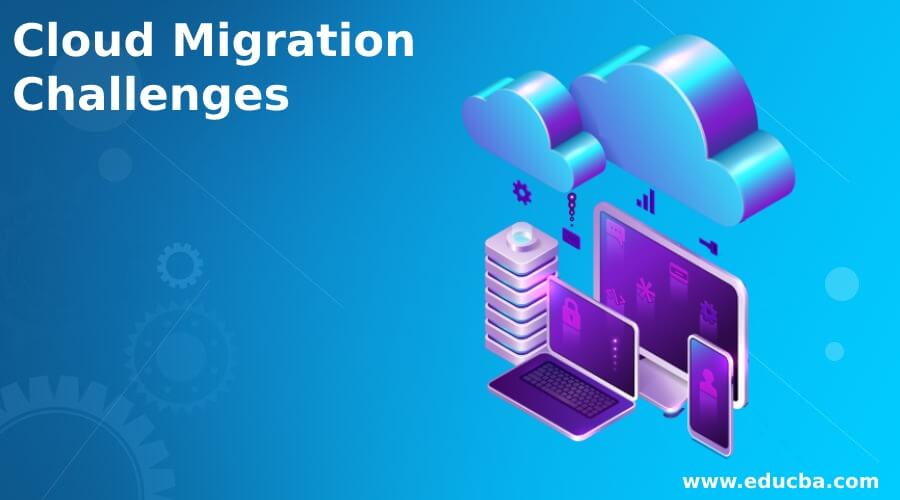Updated June 2, 2023

Introduction to Cloud Migration
The following article provides an outline for Cloud Migration Challenges. Transferring data and applications or different business elements onto a cloud computing environment is known as cloud migration. An enterprise can do many types of migrations onto a cloud environment. One of the most common ways to do it is to move the enterprise’s data and applications from a local data center to a public cloud. Cloud-to-cloud migration refers to transferring data and applications from one cloud provider to another.
Moreover, companies can perform cloud migration, known as cloud reverse migration, exit, or repatriation. The company moves the data and applications from the cloud to a local data center. However, there are several challenges associated with cloud migration.
Various Cloud Migration Challenges
Successfully transferring data onto a cloud needs complete attention from the enterprise. Insufficient preparation and readiness to handle the challenges associated with cloud migration can lead to problems in the future, potentially resulting in financial losses and data loss for the business. However, understanding these challenges and considering the trade-off between the pros and cons of cloud migration would help the business make its important decision. Moreover, understanding the challenges before migrating the data onto a cloud would benefit the business in the long run.
Here, the major challenges associated with cloud migration are listed in detail, and the ways to overcome them are given.
1. Making a Strategy for Cloud Migration
Information technology professionals understand they can’t adopt new technology without a concrete strategy. A strategy helps the business understand the pros and cons of technology and how to deal with it in case of errors and miss happenings. Cloud computing is also not untouched by this perception. Making a strategy before migrating onto the cloud is one of the most important parts of cloud migration. This not only means making a strategy for choosing the best-suited cloud provider for the organization.
Moreover, the business needs to understand the cost associated with the process, the downtime of the project, the training of the employees, and the total time taken to migrate data and applications. The last factor is one of the most important, as migrating all the data and applications can take a lot of time, depending on the business size and the amount of data being transferred onto the cloud. Sometimes, cloud migration also takes months to get completed.
2. Dividing the Complete Process into Small Stages
The worst strategy a business can make while migrating data and applications onto the cloud are simultaneously transferring everything onto the platform. Many businesses today are eager to migrate their data to the cloud. However, many often neglect to strategize which data to move first and fail to plan the migration flow. With this strategy, the company may encounter difficulties during the cloud migration, potentially leading to a disaster.
The best way to do it is to start migrating the redundant and non-essential data at the very first step, as it would help in understanding the cloud migration process without the risk of losing essential data. There is a chance that the people completing the task of cloud migration may make an error that would lead to the loss of data, corrupted files, or even not securing the data onto the cloud. Any business should not take this risk with its sensitive and vital data, which is critical, especially when maintaining compliance.
3. Cost Analysis of Cloud Migration
Migrating data and applications onto a cloud platform can be very costly; it can be higher if the business has not projected the total cost of data migration beforehand. However, data migration onto a cloud platform is very cost-effective in the long term. Still, the initial cost could be very high, which entirely depends on the size of the business and the amount of data to migrate.
The forecasting should exclude only the cost of data migration. Still, the cost of training the employees about the new technology their employer is introducing should also be considered. Moreover, the cost associated with rewriting the data or even replacing the data for making the data which would be transferred onto the cloud, compatible with the architecture of the cloud.
4. Cloud Security
Security is the most important factor a business should consider while migrating its data onto a cloud platform. This can save the business from long-term losses. Considering security as the topmost priority is always the smartest approach for the business, especially when adopting new technology. Migrating the data onto a third-party cloud platform means the business trusts a third-party organization with sensitive data.
If the cloud platform is trustworthy and has demonstrated its trustworthiness in the market, nothing can stop the business from flourishing; if it cannot be trusted, it can incur huge losses. Moreover, the business should fully understand the security practices of the cloud provider. The business should know the location of data storage, how the cloud provider encrypts the data moving in and out, and the regulations with which the provider is compliant.
Conclusion
Based on the above article, we have seen the major challenges associated with migrating data onto a cloud platform and how to overcome the challenges. The points discussed in the article would help businesses choose the best practice for their cloud migration.
Recommended Articles
This is a guide to Cloud Migration Challenges. Here we discuss the introduction and various cloud migration challenges, respectively. You may also have a look at the following articles to learn more –

